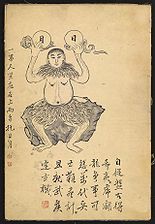Pangu was the first living being and the creator of the universe in Chinese mythology.
Etymology
Simplified: 盘古; literally "Plate Ancient"; pinyin: Pángǔ; Wade-Giles: P'an ku, romanization: P’an Ku, also spelled: Pangu)
Description
Pangu is usually depicted as a primitive, hairy giant with horns on his head and clad in furs.
Myth
These creation myths date from the 3rd to the 6th century. The first writer to record the myth of Pangu was Xu Zheng (徐整) during the Three Kingdoms (三國) period.
In the beginning there was nothing in the universe except a formless chaos. However this chaos coalesced into a cosmic egg for about 18,000 years. Within it, the perfectly opposed principles of Yin and Yang became balanced and Pangu emerged (or woke up) from the egg. Pangu set about the task of creating the world: he separated Yin from Yang with a swing of his giant axe, creating the Earth (murky Yin) and the Sky (clear Yang). To keep them separated, Pangu stood between them and pushed up the Sky. This task took 18,000 years; with each day the sky grew ten feet (3 meters) higher, the Earth ten feet wider, and Pangu ten feet taller.
In some versions of the story, Pangu is aided in this task by the four most prominent beasts, namely the Turtle, the Qilin, the Phoenix, and the Dragon.
After the 18,000 years had elapsed, Pangu was laid to rest. His breath became the wind; his voice the thunder; left eye the sun and right eye the moon; his body became the mountains and extremes of the world; his blood formed rivers; his muscles the fertile lands; his facial hair the stars and milky way; his fur the bushes and forests; his bones the valuable minerals; his bone marrows sacred diamonds; his sweat fell as rain; and the fleas on his fur carried by the wind became the fish and animals throughout the land.
Nüwa the Goddess then used the mud of the water bed to form the shape of humans. These humans were very smart since they were individually crafted.
Nüwa then became bored of individually making every human so she started putting a rope in the water bed and lettings the drops of mud that fell from it become new humans. These small drops became new humans, not as smart as the first.
Analysis
"P’an-Ku: The basic idea of the yin philosophy was so convincing that it almost obliterated the Taoist cosmology of P’an-Ku who is said to have chiseled the world out of the rocks of eternity. Though the legend is not held in high honor by the literati, it contains some features of interest which have not as yet been pointed out and deserve at least an incidental comment.
P’an-Ku is written in two ways: one means in literal translations, “basin ancient”, the other “basin solid”. Both are homophones, i.e., they are pronounced the same way; and the former may be preferred as the original and correct spelling. Obviously the name means “aboriginal abyss,” or in the terser German, Urgrund, and we have reason to believe it to be a translation of the Babylonian Tiamat, “the Deep.”
The Chinese legend tells us that P’an-Ku’s bones changed to rocks; his flesh to earth; his marrow, teeth and nails to metals; his hair to herbs and trees; his veins to rivers; his breath to wind; and his four limbs became pillars marking the four corners of the world, -- which is a Chinese version not only of the Norse myth of the Giant Ymir, but also of the Babylonian story of Tiamat.
Illustrations of P’an-Ku represent him in the company of supernatural animals that symbolize old age or immortality, viz., the tortoise and the crane; sometimes also the dragon, the emblem of power, and the phenix, the emblem of bliss.
When the earth had thus been shaped from the body of P’an-Ku, we are told that three great rivers successively governed the world: first the celestial, then the terrestrial, and finally the human sovereign. They were followed by Yung-Ch’eng and Sui-Jen (i.e., fire-man) the later being the Chinese Prometheus, who brought the fire down from heaven and taught man its various uses.
The Prometheus myth is not indigenous to Greece, where it received the artistically classical form under which it is best known to us. The name, which by an ingenious afterthought is explained as “the fore thinker,” is originally the sanskrit pramantha and means “twirler” or “fire-stick,” being the rod of hard wood which produced fire by rapid rotation in a piece of soft wood.
We cannot deny that the myth must have been known also in Mesopotamia, the main center of civilization between India and Greece, and it becomes probable that the figure Sui-Jen has been derived from the same prototype as the Greek Prometheus."
From: Paul Carus, Chinese Astrology, Early Chinese Occultism (1974), from an earlier book by the same author, Chinese Thought (1907), chapter on “Chinese Occultism.”

